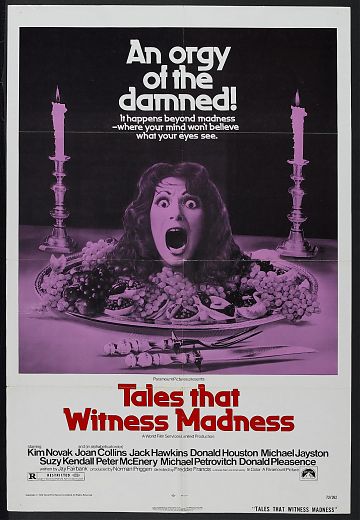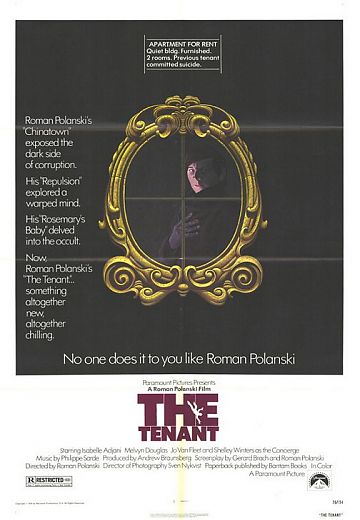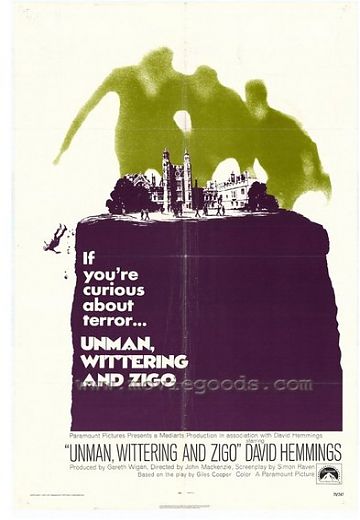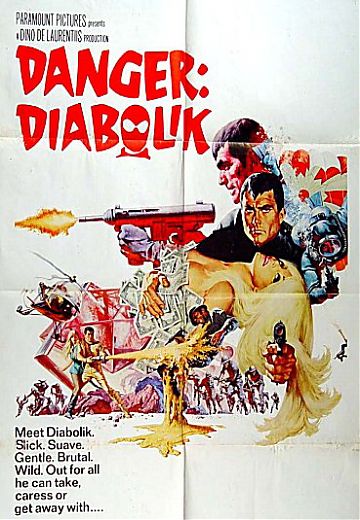David Thomson’s Have you Seen…? could easily be passed over as an old fashioned, frankly unnecessary brick of a book. At 1000 pages, this is a film guide that recalls the era when Halliwell’s, and then later perhaps Time Out, provided your unputdownable film reference. Do we need such a heavy manual in this age of gadgetry? Can’t we just look for reviews on our iPhones? Well we can, although Thomson provides a very refreshing collection of film writing that’s worth investigating if you have the muscle.
 Have you Seen...? Have you the strength to lift it?
Have you Seen...? Have you the strength to lift it?
How do you read a heavy film guide? Do you simply plough in from the start? Do you do what I did and look up all of your favourite films from memory until you are exhausted? Thomson lists his reviews alphabetically, beginning with Abbott and Costello Meet Frankenstein and ending with Zabriskie Point. He also provides a chronology, listing the films he’s covered from 1895 (L’Arrosseur Arrossé) through to 2007 (You, the Living). He doesn’t provide an index, however, so if – like me on my second interrogation of the book – you want to look up specific actors or directors, you’ll find this harder to do.
Like every film reviewer, Thomson is opinionated, and, like every film book, you’ll find opinions you’ll agree with more than others. You’ll find opinions that will make you cross. The films left out can also annoy, so while he includes Kind Hearts and Coronets, he doesn’t include The Ladykillers. Where’s Get Carter? Where’s Billy Liar and A Kind of Loving? Why does he include some tv such as The Sopranos? And so on. It’s also very easy to tell who his favourites are; he’s obviously a fan of Ridley Scott (next time you’re in the bookshop have a sneaky read of the excellent Alien review) but not so much of Spielberg. And he’ dismissive of Star Wars to the point that it’s hardly worth him including it at all. Of all the film genres out there, he’s most baffled by horror, and repeats himself several times by stating that the genre dates badly. But when he does tackle it, for example Rosemary’s Baby and The Silence of the Lambs, he writes well.
Of all the geniuses of film, Thomson writes best on Hitchcock. On Psycho:
After one of the great night drives in American film, with torment in the rearview mirror, Marion comes to a shabby motel bypassed by the new highway – in the fifties, America’s rural character was erased by freeways. Yet something remained in the bypassed spots – rancor, regret, revenge, as mothers and sons huddled together in the same lamplight.
Elsewhere in the book there’s excellent musings on Hitchcock’s other major films, as well as interesting insight into the careers of Welles, Polanski and Kubrick. But this is a film guide beyond review, mostly because I’m still reading it, and I’ll be reading it for years to come. Now I’ve got to know Thomson, agreed to disagree in several areas, I’m moving on to the discovery phase – reading about the cinema I’ve missed, avoided or simply don’t know. Because this guy has seen an awful lot of films…
As usual, we sat down to watch Jurassic Park the other evening. It’s a classic, although I’ve lost count of the number of times I’ve seen it. There does appear to be a mismatch between the films repeated endlessly on tv and the films rarely, or never, shown. So here’s some of the very obscure films I’d like to see. They are oddball films.
Oldies
Yes The Times are giving away DVDs this week for some of Alfred Hitchcock’s 30s films. All brilliant, but what about his really early films? What about The Lodger (1927) and his other silent films?
Horror
An endless list. How about The Skull (1965), a very creepy Peter Cushing film. You can catch the 1974 Amicus portmanteau Vault of Horror quite regularly, but how about Tales that Witness Madness from 1973? Then there’s Hammer, who made a series of psychological horrors in the 1960s. A couple of them, such as Paranoiac (1963), feature Oliver Reed. Here’s an actor who, up until his last celebrated film Gladiator (2000), acted in obscure films for years. He wasn’t in the pub all the time as rumour may have it, just look at Reed’s list of films.

Denis Gifford’s A Pictoral History of Horror Movies has some films so obscure that I forgive you for thinking I’ve made them up. Mad Doctor of Blood Island (1970), The Phantom of Soho (1963) and Joan Crawford in Trog (1970) for example. Trog deserves a special mention.

In her last film, Crawford plays an anthropologist who unearths a troglodyte (an Ice Age ‘missing link” half-caveman, half-ape) and manages to domesticate him – until he’s let loose by an irate land developer (Michael Gough). Alas, I’ve never seen it but I would imagine Gough to be suitably insane. He certainly is in Konga (1961) and Horror Hospital (1973).
Weirdly
You’ll only catch Roman Polanski’s The Tenant (1976) on DVD. Cul-de-sac (1966) sometimes gets an outing, but his 1972 sex comedy What? doesn’t. It’s the only film directed by Polanski that I’ve never seen and it irks me. Macbeth (1971) is easy to obtain on DVD, as is the disappointing but worth catching The Ninth Gate (1999) starring Johnny Depp.

Everyone knows The Wicker Man (1973) but have you ever seen director Robin Hardy’s only other film The Fantasist (1986) ? I did, at the time, and remember it being great.
Comedy
Harold and Maude (1970) has vanished from view. As have many more popular American comedies from the early 70s. There was a time when films featuring Alan Arkin were never off the telly. But I’ll save the comedy for another day.
Peter Sellers
Peter Sellers directed a film in 1968 called Mr Topaze. Legend has it that the mad Mr Sellers burnt all of the negatives. This makes it possibly one of the most rarely seen films ever. He made many other obscure films during his career. The Blockhouse (1973) is one of them, where he co-starred with Charles Aznavore. They play allied POWs who become entombed in a concrete bunker that’s stocked with provisions to last them several years. What’s happened to this film? Has it been entombed as well?
Terence Stamp

The veteran actor has been appearing in oddball films for nearly 50 years. The Collector (1965) is shown very rarely, and I’ve never seen the sci-fi tinged The Mind of Mr Soames (1970) or Hu-man (1975) at all. What about the Uri Geller biopic Mindbender (1996) or the strange monkey film Link (1986)? Easier to find are the deliciously oddball Elektra (2005) and Revelation (2001). He’s still at it; the prolific Mr Stamp has eight films in production in 2008. Good luck to him, although some of them sound very odd indeed.
David Hemmings

Another British actor who made many obscure films. The late Mr Hemmings appeared in Voices (1973) and Unman, Wittering and Zigo (1971). I’ve seen them both, although not for years and years. Rather than research them, I’ll just recall from memory that they were very odd and captivating films. The first, which I remember seeing in an afternoon slot, was about two people who have seemingly survived a car accident, holed up in a strange house in the country. The second was about a schoolteacher, subtly tortured by his unruly class.
60s films
Modesty Blaise (1966), another Terence Stamp oddball effort, turns up occasionally, although similar films from the period don’t turn up at all. Diabolik (1969) is a similar but much better film than Modesty Blaise.
Richard Lester made a film in 1968 starring Julie Christie called Petulia. And talking of Ms Christie, Darling (1965) has kind of disappeared from the radar.

Enough to be going on with then. One day I’ll track down my oddball films; searches for Mr Soames on YouTube return sobering footage of the MP Nicholas Soames. Although the whole of Unman, Wittering and Zigo is there in all its unadulterated glory! I’m off to enjoy…
Christopher Petit’s Radio On was made in 1979 and has achieved status as a cult, and extremely obscure, British road movie. Filmed in black and white and featuring a soundtrack including David Bowie and Kraftwerk, it’s a moody and experimental piece that offers a fascinating snapshot of England at the end of that troubled decade.

Radio On has escaped my clutches until now, so thanks to the BFI for finally releasing it on DVD. I’ve been interested in catching up with this film for what seems like an eternity; for its acclaimed soundtrack and the use of the twin locations of London and Bristol, my two home towns. The film is probably most well known for featuring Sting in an early acting role, although don’t let that put you off – his performance is far superior to the one in his other 1979 film, Quadrophenia.
Hearing of his brother’s death, a man called Robert (David Beames) embarks on a journey from London to Bristol in his unreliable Rover, encountering several odd characters on his way. A disturbed army deserter (who he wisely ditches by the roadside), a petrol pump attendant (Sting) living in his caravan shrine to Eddie Cochran (who, by no coincidence, died in a motorbike accident on the A4 where Radio On is mostly set), and a mysterious German woman looking for her daughter. Throughout the film Robert appears unable to communicate with others, left in his own thoughts he descends into a drunken spree that leaves him – literally – on the edge.
The snow covered landscape of the South West roads with their seedy filling stations and grimy cafés appears very far removed from the pristine Marks and Spencer Motos of today. Petit’s world is almost an alien one, both from the almost bygone era it represents and for the fact that it is so unlike any other British film of the period. The monochrome shots of the Westway tower blocks look distant and almost East European, and the director does like to dwell on this. There’s also the Kraftwerk tracks and Bowie screaming Heroes in German, and the suggestion that the brother has died as a result of involvement with a European porn ring. But this is no Get Carter. Robert isn’t out for revenge, he isn’t sure what he’s out for at all and the film asks more than it answers. In this way it’s extremely demanding, and what at first appears inconsequential turns out to be a deeply thought provoking look at people stranded in a tired and wasted landscape. As a period piece that looks at Britain on the edge of Thatcherism it’s as good as, if not better, than Stephen Frears’ Bloody Kids.
Yes, there’s an undeniable strange taste to much of Radio On, but it really is a work of art; and the soundtrack is so memorable because it sits so oddly with the film’s content. During the opening scene a camera roams nervously round an empty flat to the accompaniment of Bowie’s Heroes, eventually settling on an apparently dead body in a bath. Workers on a factory shop floor listen to Ian Dury’s Sweet Gene Vincent in a scene that out-weirds David Lynch. Robert lurches drunkenly in a bar to the background of Lucky Number by Lene Lovich and there’s a stunning driving scene to my favourite Bowie song, Always Crashing in the Same Car. Not everyone admires the strange beauty of the Westway or the M4, but you’ll certainly see it in this film. It’s beautifully shot and very, very strange – but well worth a look.
Films I Haven't Seen Meme
Friday June 27, 2008
in films | meme
From The Pickards.
Are there any extremely famous, worthy or acclaimed films that you’ve never made the effort to see? I’ve seen all of Hitchcock. I’ve also seen most of Truffaut. But I have a lot of gaps. In the days of video recorders I would tape worthy films, keep them for years and eventually tape over them. I kept The Mission starring Robert De Niro for years and never watched it. Films I have simply never seen and have never had the urge to see include:
- Anything with Humphrey Bogart in it
- Anything by Fellini
- My Left Foot
- Any of the Star Wars films apart from the first one
- Lawrence of Arabia
- Anything with Bette Davis in it apart from the Hammer film where she wears an eyepatch
- Born on the Fourth of July
- Any Charlie Chaplin
- There Will be Blood (has anyone actually seen this?)
- Anything by Clint Eastwood post Unforgiven
- Anything by Martin Scorsese post Goodfellas (I threw the DVD of Gangs of New York across the room)
- Practically everything by Robert Altman
- The Sound of Music, even though we have it at home on DVD
- Battleship Potemkin
- Most of what you might call The Meryl Streep Collection
- I also have a problem with Al Pacino, although I have endured Scarface
- Gone With the Wind
- 95% of Westerns
- High School Musical
- Bend it Like Beckham
- All Steven Soderbergh/George Clooney collaborations
I’d also like the time back I wasted on trying to understand the Bourne films.
Bafta Thoughts and Shane Meadows
Tuesday February 12, 2008
in films | reviews
Despite being exhausted from a hectic weekend, I valiantly sat up on Sunday night to watch the Bafta awards. I was glad I did, as most of my favourites from the last year received some recognition. Javier Bardem was named Best Supporting Actor for No Country For Old Men, Control received a screenwriting award and Atonement was named Best Film. I was also glad to see that Shane Meadows was given the award for Best British Film for This Is England. I’ve followed Meadows’ career for years, from his early short films including Small Time through to Twenty Four Seven and the excellent A Room For Romeo Brass and Dead Man’s Shoes. Like all of his work, This Is England is set in his native Midlands and follows a schoolboy’s experience of skinhead culture in 1983.
I watched This Is England the night after I’d seen the exhausting Ashes to Ashes, a new over the top TV series set in 1981 – a 1981 writ large with new romantics everywhere and a soundtrack of synthesised pop to drive you crazy. Although my classroom memories are probably more attuned to new romanticism than skinheads, I appreciated Shane Meadows film much more than Ashes to Ashes because it chose not to ram the 1980s culture, in this case mostly ugly, in my face. There was some attention to get the detail of the period correct, and, like Ashes to Ashes This Is England featured shots of clunky early computers and the fashions – skinhead or otherwise – are shockingly dated. There is also an effective montage opening the film that brought the real horror of the early 80s back for me – the Falklands War. Margaret Thatcher. But the film eavesdropped on a set of characters that are probably evident in any time; the vulnerable, the easily led and the bullies.
Tempted by the friendship and shared culture of the local skinheads, Shaun (Thomas Turgoose) is attracted by the uniform, music and petty vandalism that his new comrades can provide. This is until the edgy and unpredictible Combo (Steven Graham) returns to the gang following a spell in prison. His presence causes a rift, with particular consequences on Shaun.
Like all of Meadows’ films, there is some difficult and uncomfortable subject matter, made – like A Room For Romeo Brass – more disturbing by the involvement of impressionable children. Bleak at times This Is England does offer some hope at the end, and although it brought to mind Alan Clarke’s Made In Britain – itself made in 1983 – it wasn’t nearly as depressing in outlook. Perhaps times really have changed for the better.
None of This Is England‘s cast received awards on Sunday night and the Best Actor went to Daniel Day Lewis for There Will Be Blood, who himself appeared in another slice of social realism in My Beautiful Laundrette. This 1985 film was much lauded although I’ve always found it unrealistic – especially Day Lewis. A little too much style over content. More Ashes to Ashes than This Is England.
Previous Page |
 Have you Seen...? Have you the strength to lift it?
Have you Seen...? Have you the strength to lift it?






